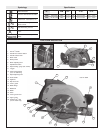
page 10
When cutting masonry, use a dry cutting diamond blade. Make succes-
sive passes at depths of less than 1/4" to achieve the desired depth.
Cutting at a depth of more than 1/4" will damage the wheel. Frequently
clean dust from air vents and guards. Always wear a dust mask.
When cutting light gauge sheet metal, use an aluminum oxide abrasive
cutting wheel or an appropriate blade designed specifically for cutting
metal. Set the depth of cut for 1/8" to 1/4" greater than the thickness of
the material you are cutting. Protect everyone in the area from sparks.
WARNING!
Only use abrasive cutting wheels with a maxi-
mum safe operating speed greater than the RPM
marked on the tool's nameplate.
WARNING!
Dust, chips and grit can cause the guard to hang
up at any time. If the saw is used with an abrasive
cutting wheel or dry cutting diamond blade, re-
serve and mark it for that use only. Before using
it for wood cutting, return it to a
MILWAUKEE
service facility for cleaning and testing.
Pocket Cutting (Fig. 19)
Pocket cuts are made in the middle of the workpiece when it can not be
cut from an edge. We recommend using a Sawzall
®
reciprocating saw or
jig saw for this type of cut. However, if you must use a circular saw to
make a pocket cut, USE EXTREME CAUTION. To maintain control of the
saw during pocket cutting, keep both hands on the saw (Fig. 19).
1. Beginning at a corner, line up the sight line with your cutting line. Tilt
the saw forward, firmly fixing the front of the shoe on the workpiece.
The blade should be just above cutting line, but not touching it. Raise
the lower guard using the lower guard lever.
2. Pull the trigger, allowing the blade to come up to full speed. Using the
front of the shoe as a hinge point, gradually lower the back end of the
saw into the workpiece.
3. When the shoe rests flat against workpiece, release the lower guard
lever. Advance the saw to the far corner. Release the trigger and
allow the blade to come to a complete stop before removing it from
workpiece. Repeat the above steps for each side of the opening. Use
a Sawzall
®
reciprocating saw, jig saw or small hand saw to finish the
corners if they are not completely cut through.
Cutting Masonry and Metal
Although
MILWAUKEE
Circular Saws are primarily designed and in-
tended for cutting wood, they may also be used with abrasive cutting
wheels or dry cutting diamond blades for cutting metal or masonry.
To reduce the risk of electric shock, check work
area for hidden pipes and wires before making
pocket cuts.
WARNING!
Fig. 19
Ripping Wood
Ripping is cutting lengthwise with the grain. Select the proper blade for
your job. Use a rip fence for rips 4" wide or less. To install the rip fence,
slide the bar through the rip fence slot in either side of the shoe. The
width of the cut is the distance from the inside of the blade to the inside
edge of the rip fence. Adjust the rip fence for the desired width, and lock
the setting by tightening the rip fence screws.
When ripping widths greater than 4", clamp or tack 1" lumber to workpiece
and use the inside edge of the shoe as a guide.
Cross-Cutting Wood (Fig. 18)
Cross-cutting is cutting across the grain. Select the proper blade for
your job. Advance the saw slowly to avoid splintering the wood.
Fig. 18
Cutting Large Panels (Fig. 17)
Large panels and long boards sag or bend if they are not correctly
supported. If you attempt to cut without leveling and properly supporting
the workpiece, the blade will tend to bind, causing KICKBACK.
Support large panels. Be sure to set the depth of the cut so that you only
cut through the workpiece, not through the supports.
Fig. 17


















